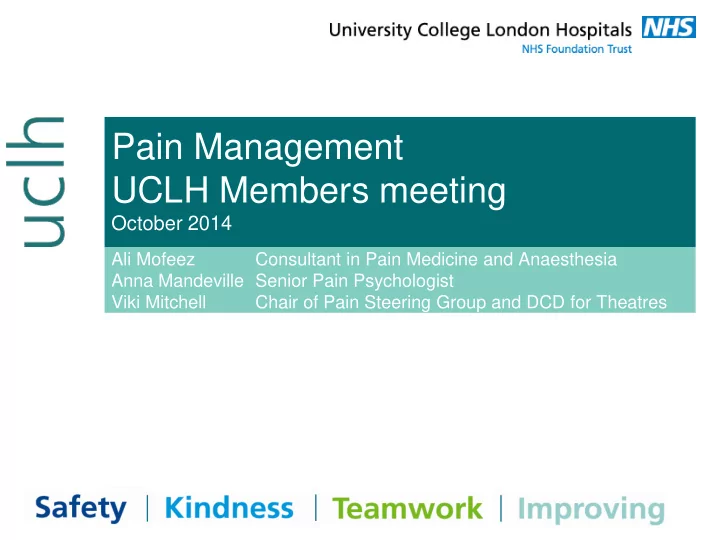

Pain Management UCLH Members meeting October 2014 Ali Mofeez Consultant in Pain Medicine and Anaesthesia Anna Mandeville Senior Pain Psychologist Viki Mitchell Chair of Pain Steering Group and DCD for Theatres Pain Steering Group Chair
Define Pain Difficult 2
Pain IASP Definition (1986): An unpleasant sensory and emotional experience associated with actual or potential tissue damage or described in terms of such damage Acute Pain Chronic Pain 3
Acute Pain ‘Good’ pain Protective, useful, necessary for survival Congenital Insensitivity to Pain (CIP) or Congenital Analgesia Rare syndrome where person cannot feel pain Children need close vigilance-injuries, burns, fractures, self- mutilation 4
Chronic Pain Definition: pain persisting for more than 3 months Not useful, complex What is prevalence of chronic pain in the population? 20-30% usually quoted 8-60% (Elliott et al, Lancet 1999) 80-85% of those Age>65 (Soares et al, 2010) 5
Impact of Chronic Pain on Patients’ Quality of Life 6
Chronic Pain: a disease not a symptom Persistent Pain: A disease entity MJ Cousins J Pain and Symptom Management 2007 Message: Chronic pain can impact on many aspects of a patient’s life Function, daily activities Mood, thoughts, emotions, behaviour Relationships (friends and family) interests, hobbies Employment, finances Overall Quality of Life 7
Who treats pain? Acute pain- All specialities with patient contact (GP, A/E, surgeons, physicians, psychiatrists) Chronic pain GP Pain Clinic Rheumatology Palliative care Haematology Neurology Complimentary/Homeopathic medicine 8
UCLH Acute Pain Services Primarily for inpatients Acute pain teams at various hospitals within the trust UCH, NHNN, HH 9
Acute Pain Services Consultants and nurses, daily ward rounds Heavily reliant on nurses/CNS Mainly for post-operative pain Oral medication, PCA’s, epidurals Mostly straightforward to manage But also many complex patients e.g. acute-on- chronic pain 10
UCLH Chronic Pain services Primarily provided on an outpatient basis Inpatients at UCH and NHNN UCH: 2-3 ward rounds per week NHNN: 1 ward round per week Outpatient services primarily at the Pain Management Centre , NHNN 11
Where are we? The Pain Management Centre, NHNN 12
Except… 13
What do we do? Historically Chronic pain services started by anaesthetists as they were already dealing with pain following surgery Hence why to this day most chronic pain doctors are anaesthetists Treatment was very medical No psychologists or physiotherapists 14
What do we do? Now moved away from the medical model Towards a Multidisciplinary Team approach Doctor, psychologist, physiotherapist, nurse 15
Why? Medically we struggle to improve patients (injections, medication effective for some but not for all, side-effects) Curing chronic pain is often not possible Medical model does not work (at the moment!) But also we know that pain is influenced by psychosocial and behavioural factors Addressing these factors can help pain 16
Chronic Pain Therapies Pain Interventions (injections, medication)- Doctors Pain Management strategies- Primarily delivered by psychologists and physiotherapists But all team members should promote pain management 17
Pain Management Team Psychologists, Physiotherapists, Nurses 1 to 1 appointments Group pain management programmes Mostly outpatient, but some inpatient programs CBT, ACT, Mindfulness 18
Overall Aim Not necessarily curing pain or a large reduction in pain intensity Instead focussing on how best to live with pain Maintaining or improving function, improving Quality of Life despite the presence of pain 19
The Future Pain in the community, primary care Traditional pain clinic patients (MSK pain, back and neck pain, Sciatic pain) are now being managed in community services Centres such as NHNN moving towards specialised pain services Complex pain Cancer pain (terminal and cured) Abdominopelvic pain Pain associated with neurological disorders Neuromodulation, SCS Facial pain Headache Pain associated with haematological disorders Inpatient chronic pain services 20
Current Projects Inpatient chronic pain services Cancer pain service 21
Inpatient chronic pain services UCH currently staffed for 2-3 ward rounds per week Doctors only, No psychologist/physiotherapist Complex patients, long inpatients stay Need to improve the service: More staff: psych/physio involvt, daily wardrounds Improve outcome, patient satisfaction, reduce hospital stay 22
Intervention Oncology Service (IOS) UCH is a major cancer referral centre Cancer patients very often have pain (>70%) Usually managed with oral analgesics But increasing numbers need interventions Eg Intrathecal Pump, nerve blocks Work in Progress! 23
Recommend
More recommend